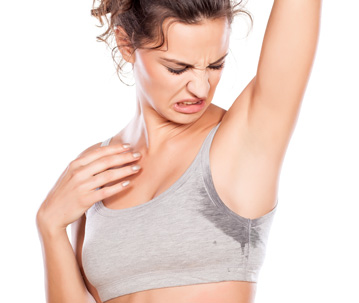Everyone sweats from time to time. Sweating is a necessary bodily function. When your body works like it should, your body produces sweat in an effort to maintain your body temperature. However, when your body produces an excessive amount of perspiration for no apparent reason, it’s often embarrassing and uncomfortable. This condition is known as hyperhidrosis.
EXCESSIVE PERSPIRATION
Hyperhidrosis is excessive sweating on the bottom of the feet, underarms or palms. About 2 to 3 percent of Americans live with this condition. Symptoms under the arms usually start appearing during late adolescence, but for the feet and palms, symptoms may appear prepubescent, as early as 13 years old.
Although hyperhidrosis isn’t life-threatening, it can cause a great deal of emotional turmoil. A person with sweaty palms may dread shaking hands. Excessive underarm sweat can ruin clothes and cause unsightly stains. And sweaty feet can ruin socks and shoes, cause foot odor, be a breeding ground for fungal infections, and limit the types of shoes that can be worn.
THE CAUSE OF EXCESSIVE PERSPIRATION
There are possibly several causes for excessive perspiration, including infections, neurological conditions and endocrine issues. However, a person without an underlying cause can still suffer from hyperhidrosis. Mood and weather can also trigger the condition in some people. No matter the cause, there are treatments available that often produce favorable results.
OPTIONS TO TREAT EXCESSIVE SWEAT
An official diagnosis from a dermatologist is often the first step in treating excessive perspiration. Make sure you find a dermatologist with experience with hyperhidrosis. Your doctor will begin with an examination of the areas of your body that produce excessive sweat. You may also undergo further testing to determine if an underlying medical condition is the root of the problem.
If no medical cause is discovered, your dermatologist may recommend several treatment options. Prescription antiperspirants are often recommended when over-the-counter antiperspirants have failed. Some people see great results from regular antiperspirants, but for most people who experience excessive perspiration, an over-the-counter antiperspirant just isn’t sufficient. Prescription antiperspirants are higher-strength than those found in the store.
The Food and Drug Administration (FDA) has approved Botox® for treating excessive underarm sweating. Botox has been shown to block the nerve signal to control excessive sweating in localized areas. Botox is highly effective at treating hyperhidrosis on the palms. It may also be used to treat excessive sweating of the underarms and feet but with varied results.
Laser treatment is another service your dermatologist might recommend. Electromagnetic energy from a laser can target and destroy underarm sweat glands. It’s a noninvasive procedure that normally takes about an hour to complete. Your dermatologist will use local anesthesia to numb the area, and your skin must cool down during a short recovery period. Underarm laser treatments generally require 2 to 3 treatments for the best results.
SURGICAL OPTIONS
In extreme cases, a surgical procedure known as thoracic sympathectomy (ETS) may be performed. This is an invasive medical procedure that requires the skills of a dermatological surgeon.
The surgeon uses an endoscopic instrument to target specific nerves that cause underarm sweating. Once the instrument is inserted into the chest, it is then placed between the ribs and underneath the armpit.
ETS has a high success rate, but the possible side-effects are risky. In addition to causing excessive perspiration in other areas, it can also possibly lead to nerve damage and lung problems.Due to the risks, this procedure is only suggested under extreme circumstances.
Is excessive perspiration ruining your quality of life? Call Adult & Pediatric Dermatology today at 913-469-1115 to schedule an appointment. Our caring professionals are here to help. Stop letting excessive perspiration ruin your life.

